DODGE RAM 2001 Service Repair Manual
Manufacturer: DODGE, Model Year: 2001, Model line: RAM, Model: DODGE RAM 2001Pages: 2889, PDF Size: 68.07 MB
Page 2701 of 2889
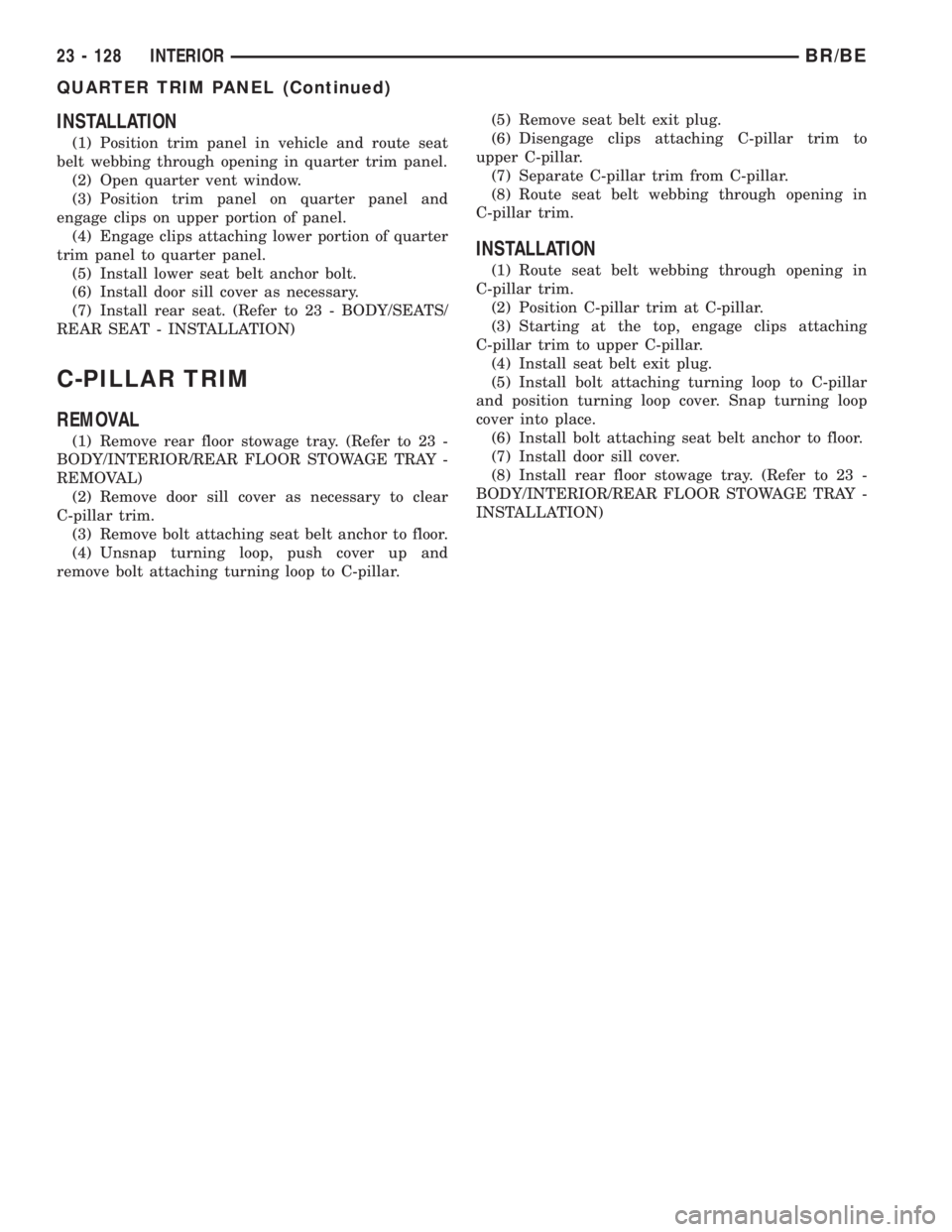
INSTALLATION
(1) Position trim panel in vehicle and route seat
belt webbing through opening in quarter trim panel.
(2) Open quarter vent window.
(3) Position trim panel on quarter panel and
engage clips on upper portion of panel.
(4) Engage clips attaching lower portion of quarter
trim panel to quarter panel.
(5) Install lower seat belt anchor bolt.
(6) Install door sill cover as necessary.
(7) Install rear seat. (Refer to 23 - BODY/SEATS/
REAR SEAT - INSTALLATION)
C-PILLAR TRIM
REMOVAL
(1) Remove rear floor stowage tray. (Refer to 23 -
BODY/INTERIOR/REAR FLOOR STOWAGE TRAY -
REMOVAL)
(2) Remove door sill cover as necessary to clear
C-pillar trim.
(3) Remove bolt attaching seat belt anchor to floor.
(4) Unsnap turning loop, push cover up and
remove bolt attaching turning loop to C-pillar.(5) Remove seat belt exit plug.
(6) Disengage clips attaching C-pillar trim to
upper C-pillar.
(7) Separate C-pillar trim from C-pillar.
(8) Route seat belt webbing through opening in
C-pillar trim.
INSTALLATION
(1) Route seat belt webbing through opening in
C-pillar trim.
(2) Position C-pillar trim at C-pillar.
(3) Starting at the top, engage clips attaching
C-pillar trim to upper C-pillar.
(4) Install seat belt exit plug.
(5) Install bolt attaching turning loop to C-pillar
and position turning loop cover. Snap turning loop
cover into place.
(6) Install bolt attaching seat belt anchor to floor.
(7) Install door sill cover.
(8) Install rear floor stowage tray. (Refer to 23 -
BODY/INTERIOR/REAR FLOOR STOWAGE TRAY -
INSTALLATION)
23 - 128 INTERIORBR/BE
QUARTER TRIM PANEL (Continued)
Page 2702 of 2889
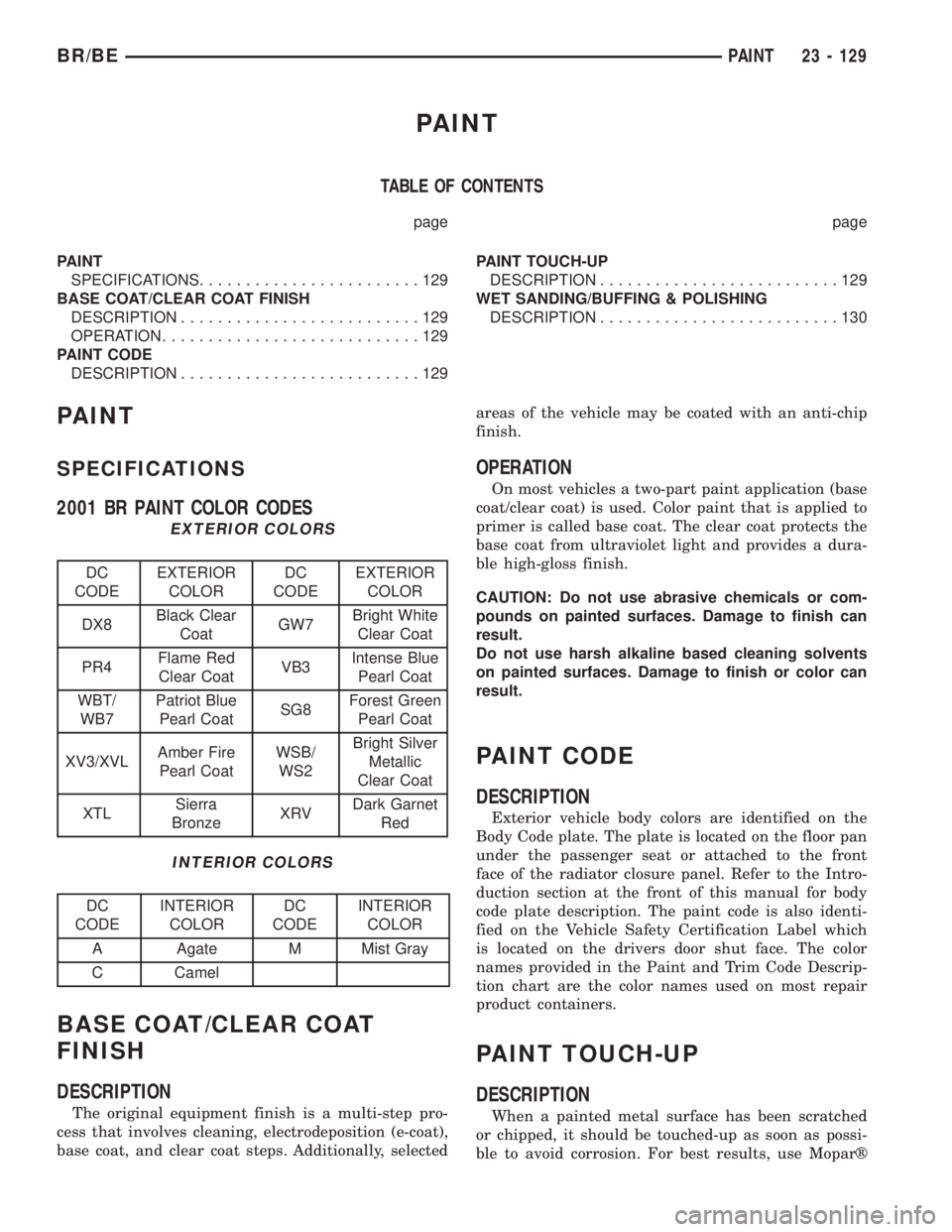
PAINT
TABLE OF CONTENTS
page page
PAINT
SPECIFICATIONS........................129
BASE COAT/CLEAR COAT FINISH
DESCRIPTION..........................129
OPERATION............................129
PAINT CODE
DESCRIPTION..........................129PAINT TOUCH-UP
DESCRIPTION..........................129
WET SANDING/BUFFING & POLISHING
DESCRIPTION..........................130
PAINT
SPECIFICATIONS
2001 BR PAINT COLOR CODES
EXTERIOR COLORS
DC
CODEEXTERIOR
COLORDC
CODEEXTERIOR
COLOR
DX8Black Clear
CoatGW7Bright White
Clear Coat
PR4Flame Red
Clear CoatVB3Intense Blue
Pearl Coat
WBT/
WB7Patriot Blue
Pearl CoatSG8Forest Green
Pearl Coat
XV3/XVLAmber Fire
Pearl CoatWSB/
WS2Bright Silver
Metallic
Clear Coat
XTLSierra
BronzeXRVDark Garnet
Red
INTERIOR COLORS
DC
CODEINTERIOR
COLORDC
CODEINTERIOR
COLOR
A Agate M Mist Gray
C Camel
BASE COAT/CLEAR COAT
FINISH
DESCRIPTION
The original equipment finish is a multi-step pro-
cess that involves cleaning, electrodeposition (e-coat),
base coat, and clear coat steps. Additionally, selectedareas of the vehicle may be coated with an anti-chip
finish.
OPERATION
On most vehicles a two-part paint application (base
coat/clear coat) is used. Color paint that is applied to
primer is called base coat. The clear coat protects the
base coat from ultraviolet light and provides a dura-
ble high-gloss finish.
CAUTION: Do not use abrasive chemicals or com-
pounds on painted surfaces. Damage to finish can
result.
Do not use harsh alkaline based cleaning solvents
on painted surfaces. Damage to finish or color can
result.
PAINT CODE
DESCRIPTION
Exterior vehicle body colors are identified on the
Body Code plate. The plate is located on the floor pan
under the passenger seat or attached to the front
face of the radiator closure panel. Refer to the Intro-
duction section at the front of this manual for body
code plate description. The paint code is also identi-
fied on the Vehicle Safety Certification Label which
is located on the drivers door shut face. The color
names provided in the Paint and Trim Code Descrip-
tion chart are the color names used on most repair
product containers.
PAINT TOUCH-UP
DESCRIPTION
When a painted metal surface has been scratched
or chipped, it should be touched-up as soon as possi-
ble to avoid corrosion. For best results, use Moparž
BR/BEPAINT 23 - 129
Page 2703 of 2889
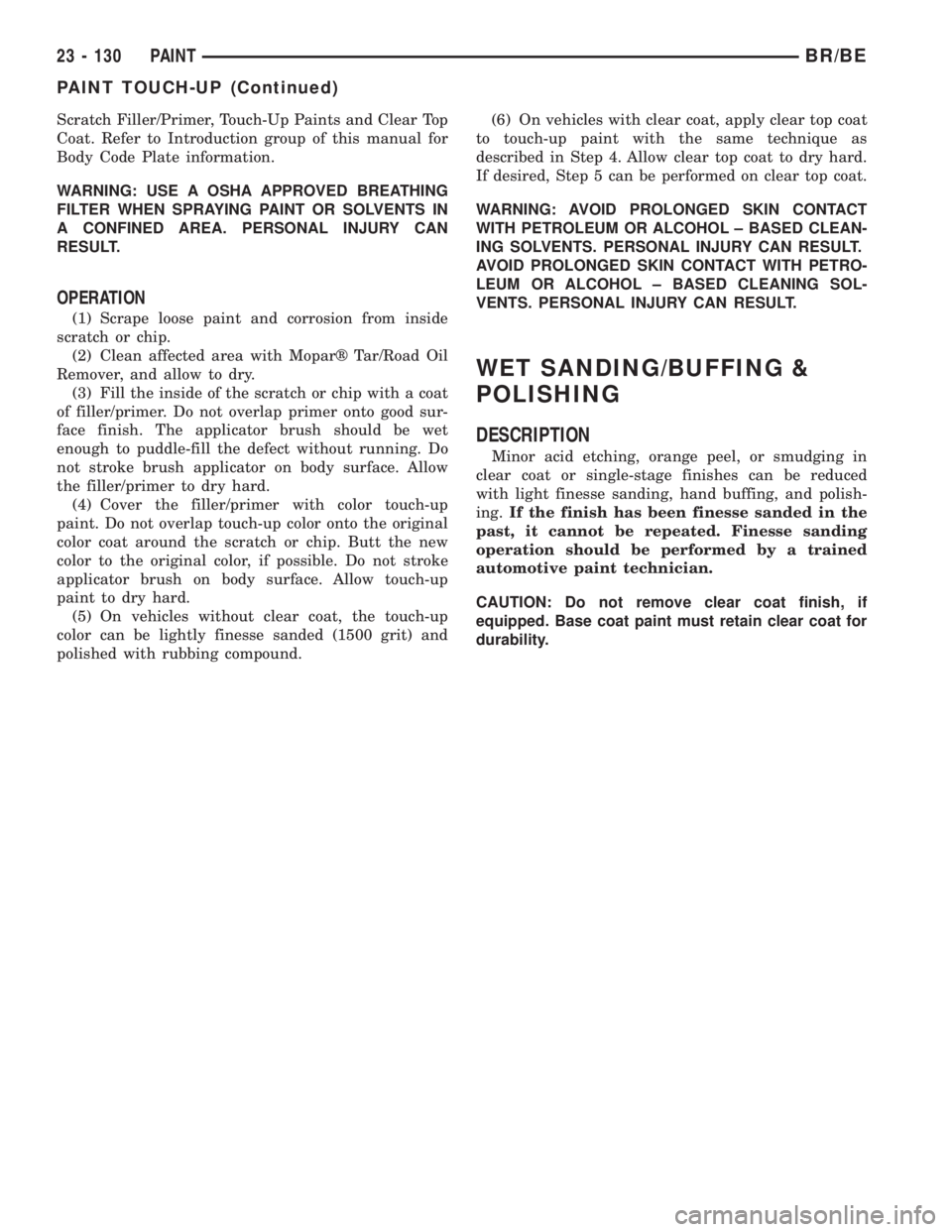
Scratch Filler/Primer, Touch-Up Paints and Clear Top
Coat. Refer to Introduction group of this manual for
Body Code Plate information.
WARNING: USE A OSHA APPROVED BREATHING
FILTER WHEN SPRAYING PAINT OR SOLVENTS IN
A CONFINED AREA. PERSONAL INJURY CAN
RESULT.
OPERATION
(1) Scrape loose paint and corrosion from inside
scratch or chip.
(2) Clean affected area with Moparž Tar/Road Oil
Remover, and allow to dry.
(3) Fill the inside of the scratch or chip with a coat
of filler/primer. Do not overlap primer onto good sur-
face finish. The applicator brush should be wet
enough to puddle-fill the defect without running. Do
not stroke brush applicator on body surface. Allow
the filler/primer to dry hard.
(4) Cover the filler/primer with color touch-up
paint. Do not overlap touch-up color onto the original
color coat around the scratch or chip. Butt the new
color to the original color, if possible. Do not stroke
applicator brush on body surface. Allow touch-up
paint to dry hard.
(5) On vehicles without clear coat, the touch-up
color can be lightly finesse sanded (1500 grit) and
polished with rubbing compound.(6) On vehicles with clear coat, apply clear top coat
to touch-up paint with the same technique as
described in Step 4. Allow clear top coat to dry hard.
If desired, Step 5 can be performed on clear top coat.
WARNING: AVOID PROLONGED SKIN CONTACT
WITH PETROLEUM OR ALCOHOL ± BASED CLEAN-
ING SOLVENTS. PERSONAL INJURY CAN RESULT.
AVOID PROLONGED SKIN CONTACT WITH PETRO-
LEUM OR ALCOHOL ± BASED CLEANING SOL-
VENTS. PERSONAL INJURY CAN RESULT.
WET SANDING/BUFFING &
POLISHING
DESCRIPTION
Minor acid etching, orange peel, or smudging in
clear coat or single-stage finishes can be reduced
with light finesse sanding, hand buffing, and polish-
ing.If the finish has been finesse sanded in the
past, it cannot be repeated. Finesse sanding
operation should be performed by a trained
automotive paint technician.
CAUTION: Do not remove clear coat finish, if
equipped. Base coat paint must retain clear coat for
durability.
23 - 130 PAINTBR/BE
PAINT TOUCH-UP (Continued)
Page 2704 of 2889
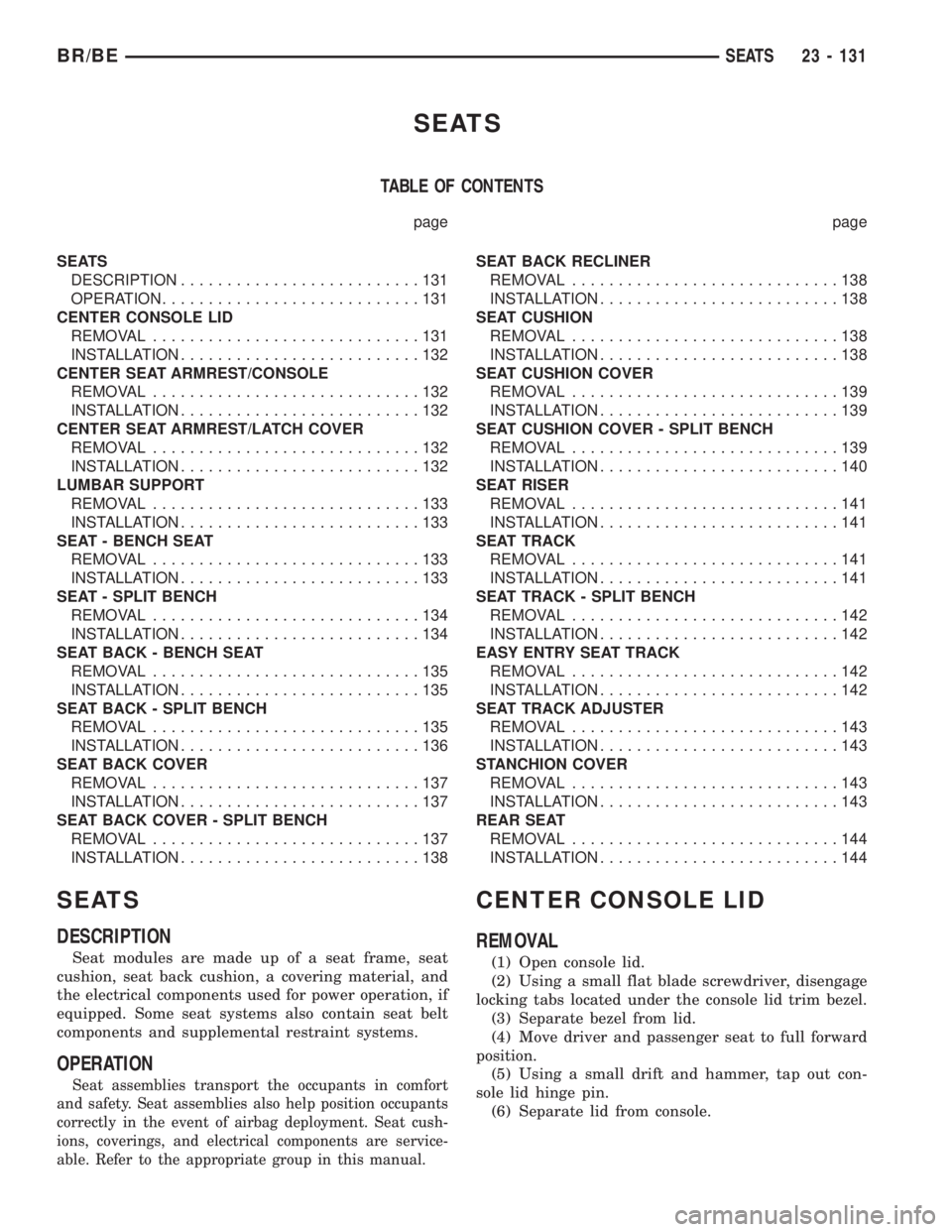
SEATS
TABLE OF CONTENTS
page page
SEATS
DESCRIPTION..........................131
OPERATION............................131
CENTER CONSOLE LID
REMOVAL.............................131
INSTALLATION..........................132
CENTER SEAT ARMREST/CONSOLE
REMOVAL.............................132
INSTALLATION..........................132
CENTER SEAT ARMREST/LATCH COVER
REMOVAL.............................132
INSTALLATION..........................132
LUMBAR SUPPORT
REMOVAL.............................133
INSTALLATION..........................133
SEAT - BENCH SEAT
REMOVAL.............................133
INSTALLATION..........................133
SEAT - SPLIT BENCH
REMOVAL.............................134
INSTALLATION..........................134
SEAT BACK - BENCH SEAT
REMOVAL.............................135
INSTALLATION..........................135
SEAT BACK - SPLIT BENCH
REMOVAL.............................135
INSTALLATION..........................136
SEAT BACK COVER
REMOVAL.............................137
INSTALLATION..........................137
SEAT BACK COVER - SPLIT BENCH
REMOVAL.............................137
INSTALLATION..........................138SEAT BACK RECLINER
REMOVAL.............................138
INSTALLATION..........................138
SEAT CUSHION
REMOVAL.............................138
INSTALLATION..........................138
SEAT CUSHION COVER
REMOVAL.............................139
INSTALLATION..........................139
SEAT CUSHION COVER - SPLIT BENCH
REMOVAL.............................139
INSTALLATION..........................140
SEAT RISER
REMOVAL.............................141
INSTALLATION..........................141
SEAT TRACK
REMOVAL.............................141
INSTALLATION..........................141
SEAT TRACK - SPLIT BENCH
REMOVAL.............................142
INSTALLATION..........................142
EASY ENTRY SEAT TRACK
REMOVAL.............................142
INSTALLATION..........................142
SEAT TRACK ADJUSTER
REMOVAL.............................143
INSTALLATION..........................143
STANCHION COVER
REMOVAL.............................143
INSTALLATION..........................143
REAR SEAT
REMOVAL.............................144
INSTALLATION..........................144
SEATS
DESCRIPTION
Seat modules are made up of a seat frame, seat
cushion, seat back cushion, a covering material, and
the electrical components used for power operation, if
equipped. Some seat systems also contain seat belt
components and supplemental restraint systems.
OPERATION
Seat assemblies transport the occupants in comfort
and safety. Seat assemblies also help position occupants
correctly in the event of airbag deployment. Seat cush-
ions, coverings, and electrical components are service-
able. Refer to the appropriate group in this manual.
CENTER CONSOLE LID
REMOVAL
(1) Open console lid.
(2) Using a small flat blade screwdriver, disengage
locking tabs located under the console lid trim bezel.
(3) Separate bezel from lid.
(4) Move driver and passenger seat to full forward
position.
(5) Using a small drift and hammer, tap out con-
sole lid hinge pin.
(6) Separate lid from console.
BR/BESEATS 23 - 131
Page 2705 of 2889
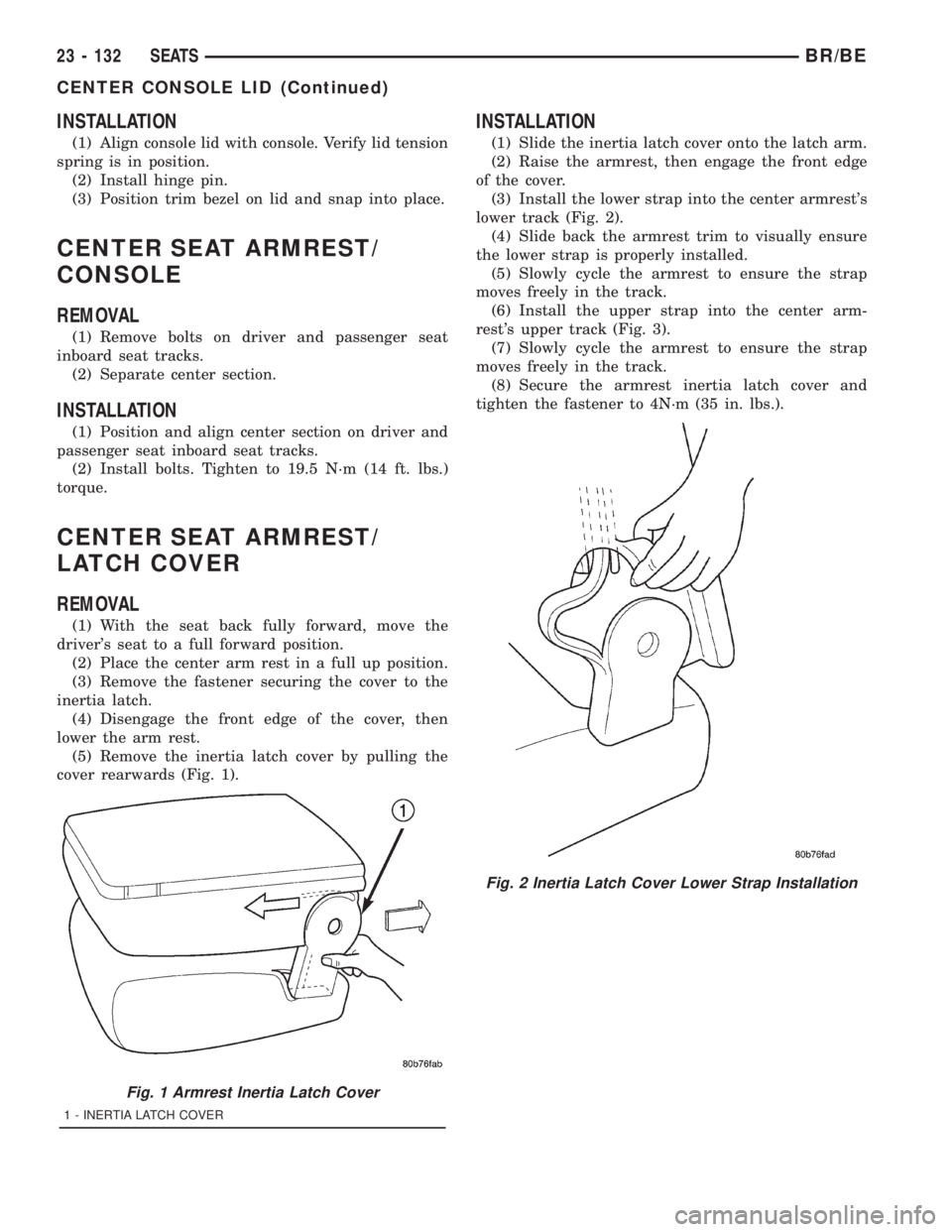
INSTALLATION
(1) Align console lid with console. Verify lid tension
spring is in position.
(2) Install hinge pin.
(3) Position trim bezel on lid and snap into place.
CENTER SEAT ARMREST/
CONSOLE
REMOVAL
(1) Remove bolts on driver and passenger seat
inboard seat tracks.
(2) Separate center section.
INSTALLATION
(1) Position and align center section on driver and
passenger seat inboard seat tracks.
(2) Install bolts. Tighten to 19.5 N´m (14 ft. lbs.)
torque.
CENTER SEAT ARMREST/
LATCH COVER
REMOVAL
(1) With the seat back fully forward, move the
driver's seat to a full forward position.
(2) Place the center arm rest in a full up position.
(3) Remove the fastener securing the cover to the
inertia latch.
(4) Disengage the front edge of the cover, then
lower the arm rest.
(5) Remove the inertia latch cover by pulling the
cover rearwards (Fig. 1).
INSTALLATION
(1) Slide the inertia latch cover onto the latch arm.
(2) Raise the armrest, then engage the front edge
of the cover.
(3) Install the lower strap into the center armrest's
lower track (Fig. 2).
(4) Slide back the armrest trim to visually ensure
the lower strap is properly installed.
(5) Slowly cycle the armrest to ensure the strap
moves freely in the track.
(6) Install the upper strap into the center arm-
rest's upper track (Fig. 3).
(7) Slowly cycle the armrest to ensure the strap
moves freely in the track.
(8) Secure the armrest inertia latch cover and
tighten the fastener to 4N´m (35 in. lbs.).
Fig. 1 Armrest Inertia Latch Cover
1 - INERTIA LATCH COVER
Fig. 2 Inertia Latch Cover Lower Strap Installation
23 - 132 SEATSBR/BE
CENTER CONSOLE LID (Continued)
Page 2706 of 2889
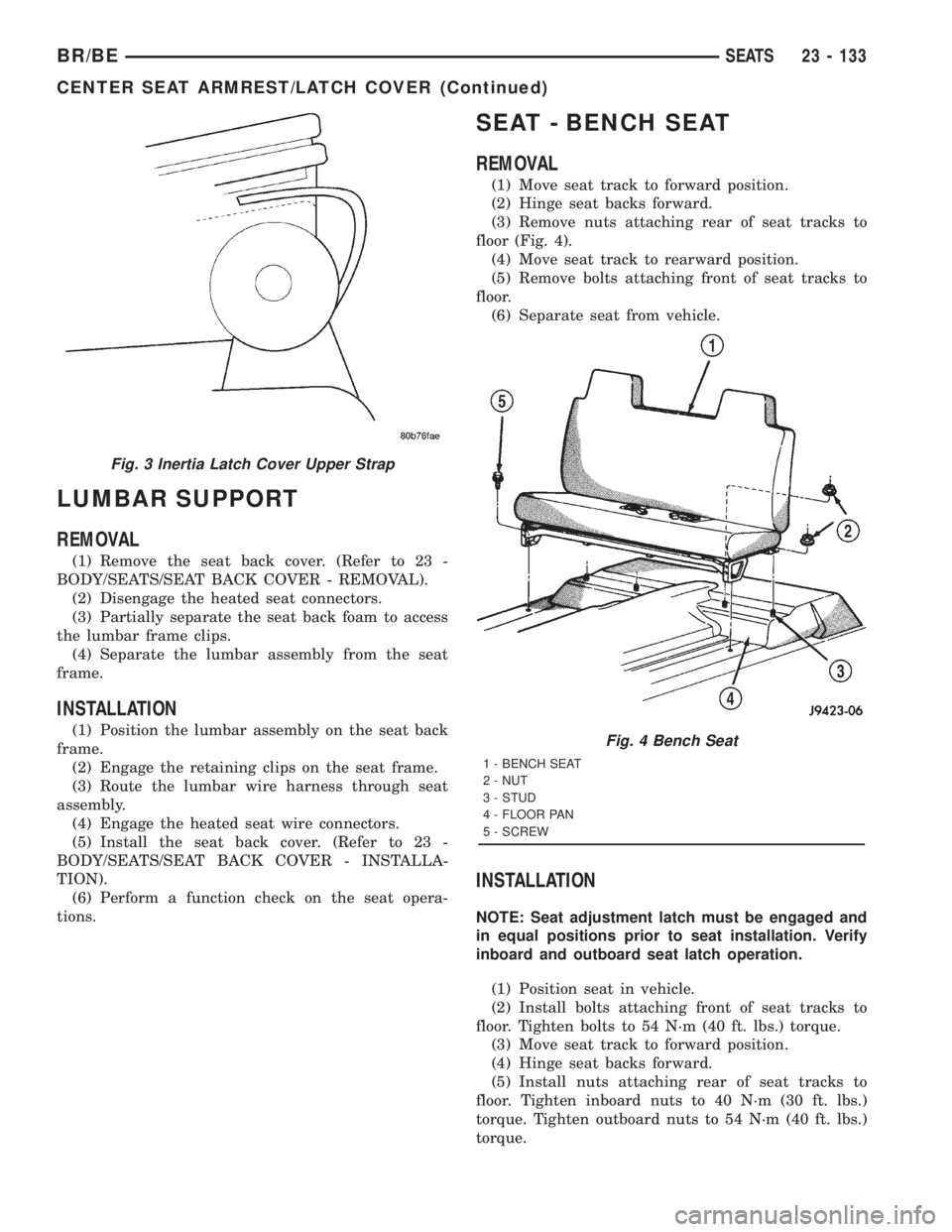
LUMBAR SUPPORT
REMOVAL
(1) Remove the seat back cover. (Refer to 23 -
BODY/SEATS/SEAT BACK COVER - REMOVAL).
(2) Disengage the heated seat connectors.
(3) Partially separate the seat back foam to access
the lumbar frame clips.
(4) Separate the lumbar assembly from the seat
frame.
INSTALLATION
(1) Position the lumbar assembly on the seat back
frame.
(2) Engage the retaining clips on the seat frame.
(3) Route the lumbar wire harness through seat
assembly.
(4) Engage the heated seat wire connectors.
(5) Install the seat back cover. (Refer to 23 -
BODY/SEATS/SEAT BACK COVER - INSTALLA-
TION).
(6) Perform a function check on the seat opera-
tions.
SEAT - BENCH SEAT
REMOVAL
(1) Move seat track to forward position.
(2) Hinge seat backs forward.
(3) Remove nuts attaching rear of seat tracks to
floor (Fig. 4).
(4) Move seat track to rearward position.
(5) Remove bolts attaching front of seat tracks to
floor.
(6) Separate seat from vehicle.
INSTALLATION
NOTE: Seat adjustment latch must be engaged and
in equal positions prior to seat installation. Verify
inboard and outboard seat latch operation.
(1) Position seat in vehicle.
(2) Install bolts attaching front of seat tracks to
floor. Tighten bolts to 54 N´m (40 ft. lbs.) torque.
(3) Move seat track to forward position.
(4) Hinge seat backs forward.
(5) Install nuts attaching rear of seat tracks to
floor. Tighten inboard nuts to 40 N´m (30 ft. lbs.)
torque. Tighten outboard nuts to 54 N´m (40 ft. lbs.)
torque.
Fig. 3 Inertia Latch Cover Upper Strap
Fig. 4 Bench Seat
1 - BENCH SEAT
2 - NUT
3 - STUD
4 - FLOOR PAN
5 - SCREW
BR/BESEATS 23 - 133
CENTER SEAT ARMREST/LATCH COVER (Continued)
Page 2707 of 2889
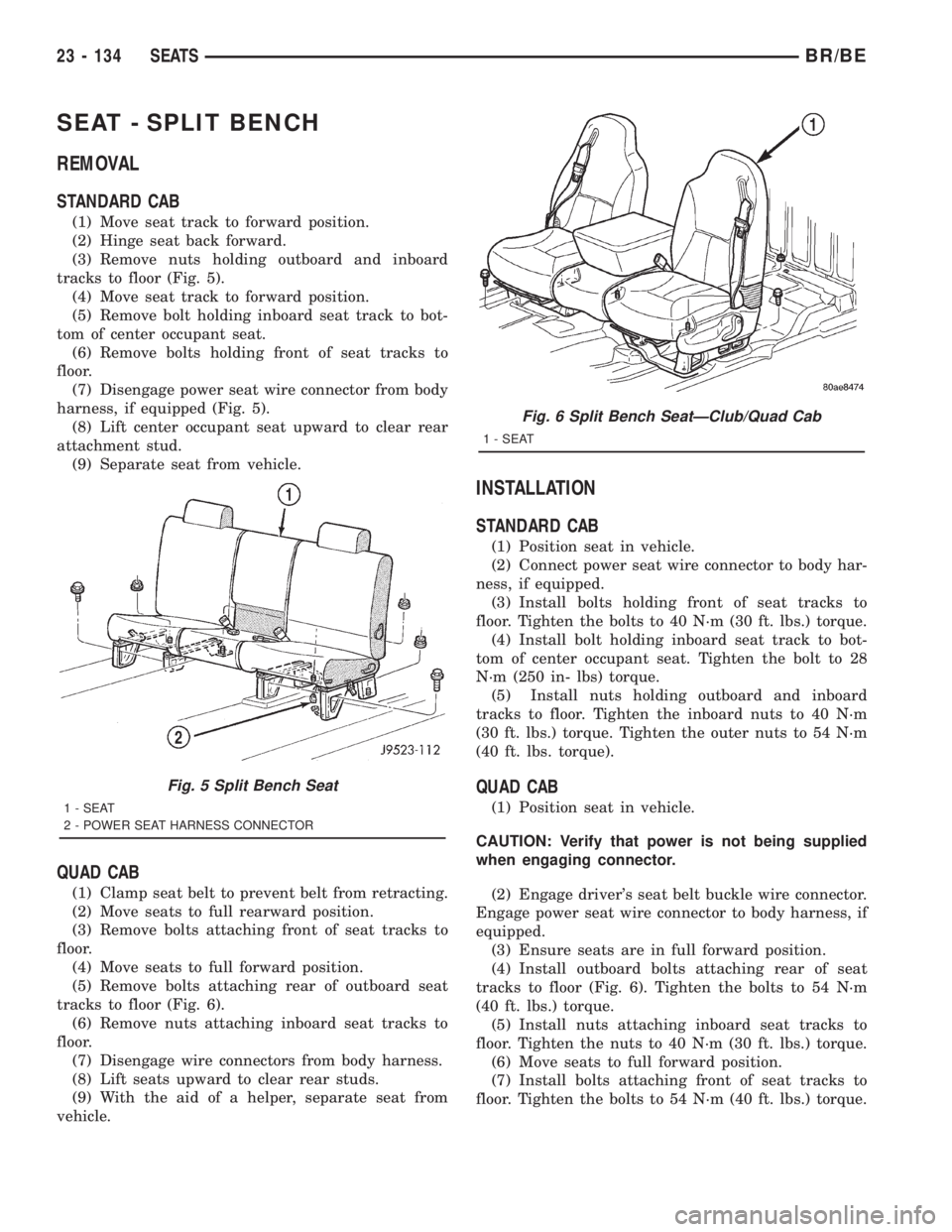
SEAT - SPLIT BENCH
REMOVAL
STANDARD CAB
(1) Move seat track to forward position.
(2) Hinge seat back forward.
(3) Remove nuts holding outboard and inboard
tracks to floor (Fig. 5).
(4) Move seat track to forward position.
(5) Remove bolt holding inboard seat track to bot-
tom of center occupant seat.
(6) Remove bolts holding front of seat tracks to
floor.
(7) Disengage power seat wire connector from body
harness, if equipped (Fig. 5).
(8) Lift center occupant seat upward to clear rear
attachment stud.
(9) Separate seat from vehicle.
QUAD CAB
(1) Clamp seat belt to prevent belt from retracting.
(2) Move seats to full rearward position.
(3) Remove bolts attaching front of seat tracks to
floor.
(4) Move seats to full forward position.
(5) Remove bolts attaching rear of outboard seat
tracks to floor (Fig. 6).
(6) Remove nuts attaching inboard seat tracks to
floor.
(7) Disengage wire connectors from body harness.
(8) Lift seats upward to clear rear studs.
(9) With the aid of a helper, separate seat from
vehicle.
INSTALLATION
STANDARD CAB
(1) Position seat in vehicle.
(2) Connect power seat wire connector to body har-
ness, if equipped.
(3) Install bolts holding front of seat tracks to
floor. Tighten the bolts to 40 N´m (30 ft. lbs.) torque.
(4) Install bolt holding inboard seat track to bot-
tom of center occupant seat. Tighten the bolt to 28
N´m (250 in- lbs) torque.
(5) Install nuts holding outboard and inboard
tracks to floor. Tighten the inboard nuts to 40 N´m
(30 ft. lbs.) torque. Tighten the outer nuts to 54 N´m
(40 ft. lbs. torque).
QUAD CAB
(1) Position seat in vehicle.
CAUTION: Verify that power is not being supplied
when engaging connector.
(2) Engage driver's seat belt buckle wire connector.
Engage power seat wire connector to body harness, if
equipped.
(3) Ensure seats are in full forward position.
(4) Install outboard bolts attaching rear of seat
tracks to floor (Fig. 6). Tighten the bolts to 54 N´m
(40 ft. lbs.) torque.
(5) Install nuts attaching inboard seat tracks to
floor. Tighten the nuts to 40 N´m (30 ft. lbs.) torque.
(6) Move seats to full forward position.
(7) Install bolts attaching front of seat tracks to
floor. Tighten the bolts to 54 N´m (40 ft. lbs.) torque.
Fig. 5 Split Bench Seat
1 - SEAT
2 - POWER SEAT HARNESS CONNECTOR
Fig. 6 Split Bench SeatÐClub/Quad Cab
1 - SEAT
23 - 134 SEATSBR/BE
Page 2708 of 2889
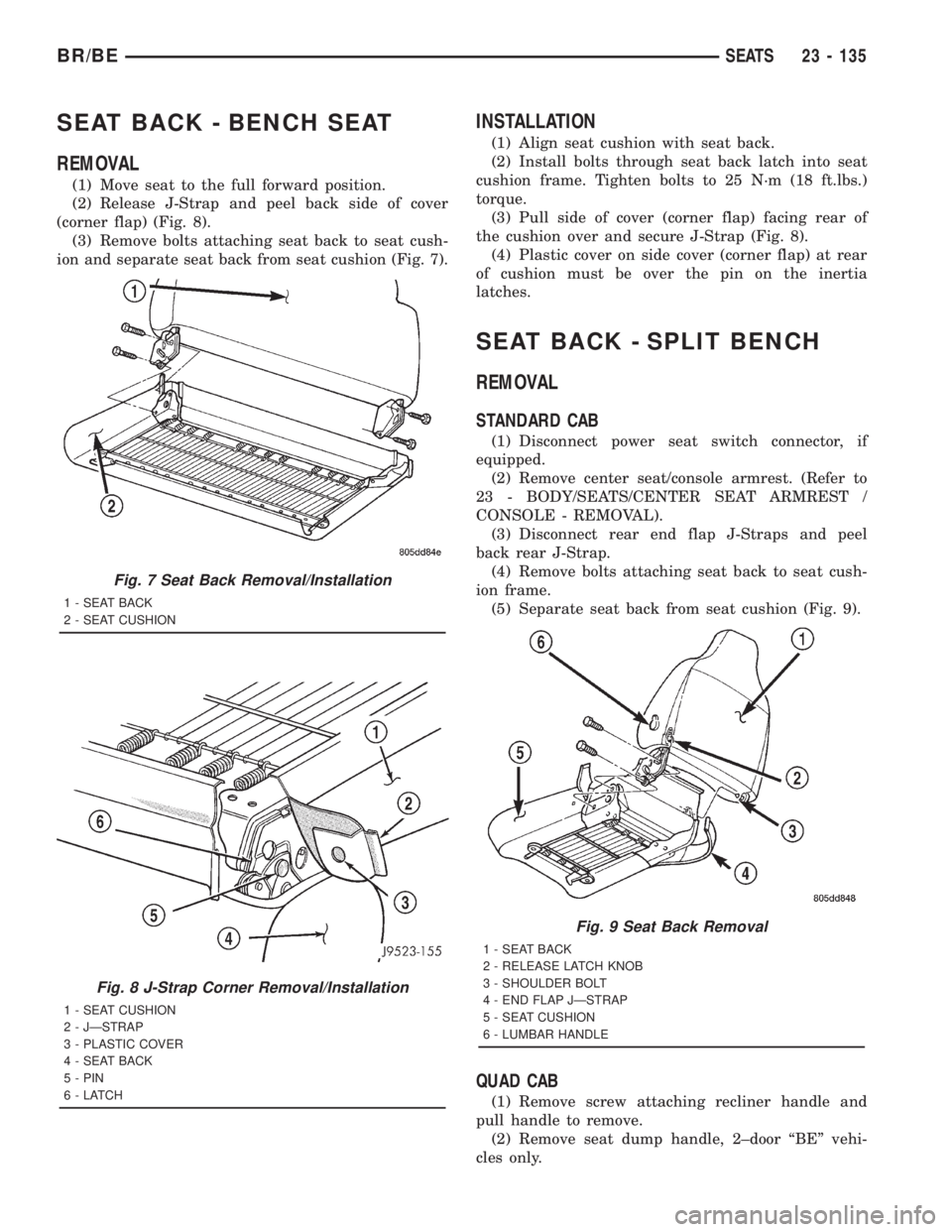
SEAT BACK - BENCH SEAT
REMOVAL
(1) Move seat to the full forward position.
(2) Release J-Strap and peel back side of cover
(corner flap) (Fig. 8).
(3) Remove bolts attaching seat back to seat cush-
ion and separate seat back from seat cushion (Fig. 7).
INSTALLATION
(1) Align seat cushion with seat back.
(2) Install bolts through seat back latch into seat
cushion frame. Tighten bolts to 25 N´m (18 ft.lbs.)
torque.
(3) Pull side of cover (corner flap) facing rear of
the cushion over and secure J-Strap (Fig. 8).
(4) Plastic cover on side cover (corner flap) at rear
of cushion must be over the pin on the inertia
latches.
SEAT BACK - SPLIT BENCH
REMOVAL
STANDARD CAB
(1) Disconnect power seat switch connector, if
equipped.
(2) Remove center seat/console armrest. (Refer to
23 - BODY/SEATS/CENTER SEAT ARMREST /
CONSOLE - REMOVAL).
(3) Disconnect rear end flap J-Straps and peel
back rear J-Strap.
(4) Remove bolts attaching seat back to seat cush-
ion frame.
(5) Separate seat back from seat cushion (Fig. 9).
QUAD CAB
(1) Remove screw attaching recliner handle and
pull handle to remove.
(2) Remove seat dump handle, 2±door ªBEº vehi-
cles only.
Fig. 7 Seat Back Removal/Installation
1 - SEAT BACK
2 - SEAT CUSHION
Fig. 8 J-Strap Corner Removal/Installation
1 - SEAT CUSHION
2 - JÐSTRAP
3 - PLASTIC COVER
4 - SEAT BACK
5 - PIN
6-LATCH
Fig. 9 Seat Back Removal
1 - SEAT BACK
2 - RELEASE LATCH KNOB
3 - SHOULDER BOLT
4 - END FLAP JÐSTRAP
5 - SEAT CUSHION
6 - LUMBAR HANDLE
BR/BESEATS 23 - 135
Page 2709 of 2889
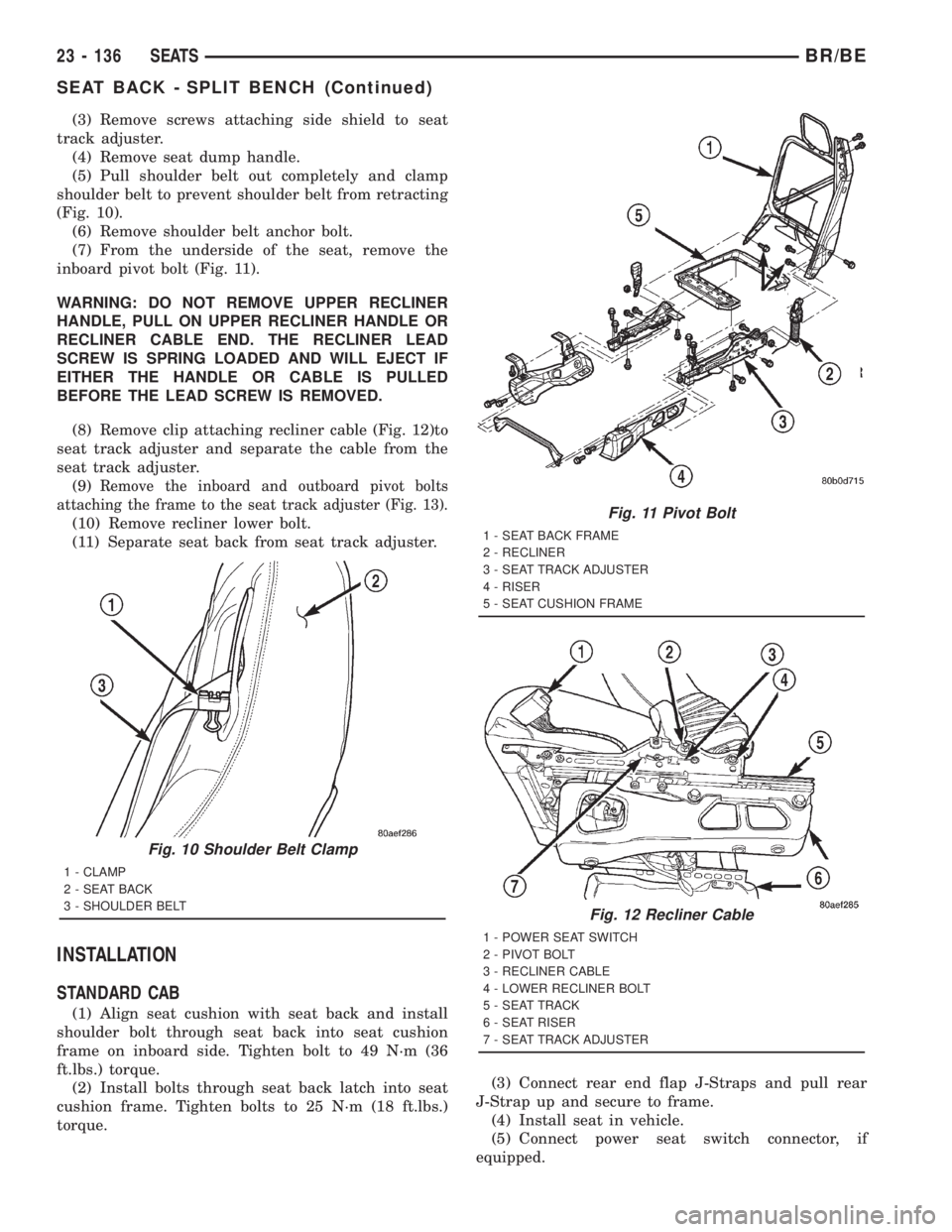
(3) Remove screws attaching side shield to seat
track adjuster.
(4) Remove seat dump handle.
(5) Pull shoulder belt out completely and clamp
shoulder belt to prevent shoulder belt from retracting
(Fig. 10).
(6) Remove shoulder belt anchor bolt.
(7) From the underside of the seat, remove the
inboard pivot bolt (Fig. 11).
WARNING: DO NOT REMOVE UPPER RECLINER
HANDLE, PULL ON UPPER RECLINER HANDLE OR
RECLINER CABLE END. THE RECLINER LEAD
SCREW IS SPRING LOADED AND WILL EJECT IF
EITHER THE HANDLE OR CABLE IS PULLED
BEFORE THE LEAD SCREW IS REMOVED.
(8) Remove clip attaching recliner cable (Fig. 12)to
seat track adjuster and separate the cable from the
seat track adjuster.
(9)
Remove the inboard and outboard pivot bolts
attaching the frame to the seat track adjuster (Fig. 13).
(10) Remove recliner lower bolt.
(11) Separate seat back from seat track adjuster.
INSTALLATION
STANDARD CAB
(1) Align seat cushion with seat back and install
shoulder bolt through seat back into seat cushion
frame on inboard side. Tighten bolt to 49 N´m (36
ft.lbs.) torque.
(2) Install bolts through seat back latch into seat
cushion frame. Tighten bolts to 25 N´m (18 ft.lbs.)
torque.(3) Connect rear end flap J-Straps and pull rear
J-Strap up and secure to frame.
(4) Install seat in vehicle.
(5) Connect power seat switch connector, if
equipped.
Fig. 10 Shoulder Belt Clamp
1 - CLAMP
2 - SEAT BACK
3 - SHOULDER BELT
Fig. 11 Pivot Bolt
1 - SEAT BACK FRAME
2 - RECLINER
3 - SEAT TRACK ADJUSTER
4 - RISER
5 - SEAT CUSHION FRAME
Fig. 12 Recliner Cable
1 - POWER SEAT SWITCH
2 - PIVOT BOLT
3 - RECLINER CABLE
4 - LOWER RECLINER BOLT
5 - SEAT TRACK
6 - SEAT RISER
7 - SEAT TRACK ADJUSTER
23 - 136 SEATSBR/BE
SEAT BACK - SPLIT BENCH (Continued)
Page 2710 of 2889
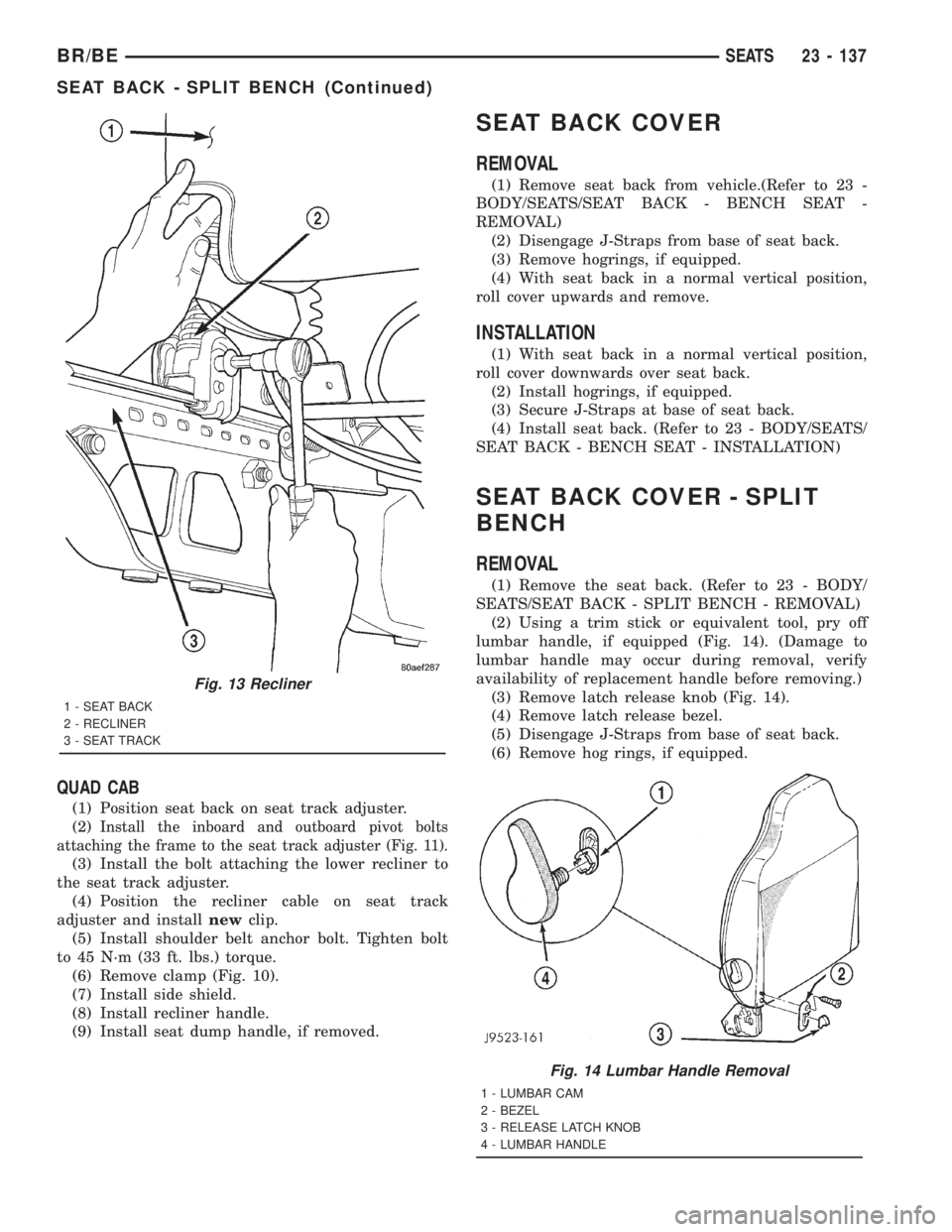
QUAD CAB
(1) Position seat back on seat track adjuster.
(2)
Install the inboard and outboard pivot bolts
attaching the frame to the seat track adjuster (Fig. 11).
(3) Install the bolt attaching the lower recliner to
the seat track adjuster.
(4) Position the recliner cable on seat track
adjuster and installnewclip.
(5) Install shoulder belt anchor bolt. Tighten bolt
to 45 N´m (33 ft. lbs.) torque.
(6) Remove clamp (Fig. 10).
(7) Install side shield.
(8) Install recliner handle.
(9) Install seat dump handle, if removed.
SEAT BACK COVER
REMOVAL
(1) Remove seat back from vehicle.(Refer to 23 -
BODY/SEATS/SEAT BACK - BENCH SEAT -
REMOVAL)
(2) Disengage J-Straps from base of seat back.
(3) Remove hogrings, if equipped.
(4) With seat back in a normal vertical position,
roll cover upwards and remove.
INSTALLATION
(1) With seat back in a normal vertical position,
roll cover downwards over seat back.
(2) Install hogrings, if equipped.
(3) Secure J-Straps at base of seat back.
(4) Install seat back. (Refer to 23 - BODY/SEATS/
SEAT BACK - BENCH SEAT - INSTALLATION)
SEAT BACK COVER - SPLIT
BENCH
REMOVAL
(1) Remove the seat back. (Refer to 23 - BODY/
SEATS/SEAT BACK - SPLIT BENCH - REMOVAL)
(2) Using a trim stick or equivalent tool, pry off
lumbar handle, if equipped (Fig. 14). (Damage to
lumbar handle may occur during removal, verify
availability of replacement handle before removing.)
(3) Remove latch release knob (Fig. 14).
(4) Remove latch release bezel.
(5) Disengage J-Straps from base of seat back.
(6) Remove hog rings, if equipped.
Fig. 14 Lumbar Handle Removal
1 - LUMBAR CAM
2 - BEZEL
3 - RELEASE LATCH KNOB
4 - LUMBAR HANDLE
Fig. 13 Recliner
1 - SEAT BACK
2 - RECLINER
3 - SEAT TRACK
BR/BESEATS 23 - 137
SEAT BACK - SPLIT BENCH (Continued)